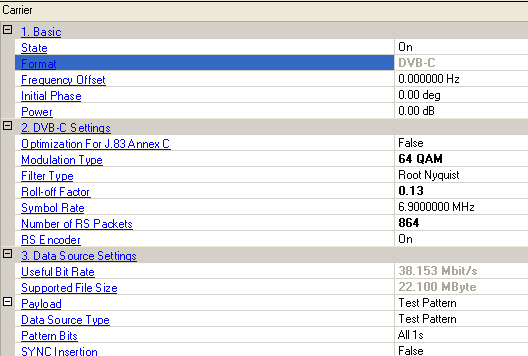
Digital Video Broadcasting Cable (DVB-C) is known as the digital multi-program television distribution system by cable. The DVB-C transmission standard is based on the MPEG-2 system layer, with the addition of appropriate forward error correction (FEC) technique. The system FEC is designed to improve bit error ratio (BER) from 10-4 to a range, 10-10 to 10-11, ensuring quasi error free (QEF) operation with approximately one uncorrected error event per transmission hour. DVB-C is based on quadrature amplitude modulation (QAM) and it allows for 16, 32, 64, 128 or 256-QAM constellations.

Multi-path Channel and Known Bit Error Rate (not shown above) are new parameters under 2. DVB-C Settings.
Choice: On |Off
Default: On
Double-click or use the drop-down menu to control the operating state of the carrier.
The format of the carrier.
Range: -40.0 to 40.0 MHz
Set the frequency offset for the carrier relative to the signal generator’s frequency setting. The valid range will be different for every format due to the different over-sampling ratios.
For example, for 2 carriers configuration, set the center frequency of signal generator to 1 GHz, and make the two carriers distributed on the both sides of the
Range: 0 to 359 degrees
Set the initial phase of the carrier.
Range: -50 to 0 dB
Set the carrier’s power relative to the signal generator’s amplitude setting.
Choice: True |False
Default: False
J.83-A/B/C, standardized by the International Telecommunications Union, is the specification for cable modulation schemes used for transmission of digital video and audio for different geographies.
ITU-T J.83 Annex B: describes the framing structure, channel coding, and modulation schemes for digital cable service in North America.
J.83 Annex A and J.83 Annex C: defines the cable modulation schemes for Japanese and European regions, respectively.
Double-click or use the drop-down menu to select the modulation type.
When Optimization For J.83 Annex C is False:
Choice: 16QAM \32QAM \64QAM \128QAM \256QAM\1024QAM
Default: 16QAM
When Optimization For J.83 Annex C is True:
Choice: 64QAM
This parameter is not editable.
1024 QAM is only available when Minor Enhancement Update (MEU) Option U01 or greater is valid. Refer to Licenses for more information.
Choice: Nyquist \Root Nyquist
Default: Root Nyquist
Double-click or use the drop-down menu to select the filter type.
Conventionally, a data transmission system employs a Nyquist filter whose reply for an impulse is zero (0) for every interval T just before and after a peak (T: data transmission interval). As replies of adjacent data are zero on a sample point of other sampled data, interference between codes can be prevented.
To function as above, a Nyquist filter whose amplitude becomes half at the point where Nyquist frequency fN (=1/2T) is used, and it is odd-symmetrically rolled off with a squared cosine around the half amplitude point in the cutoff area. In this case the phase characteristics is not considered, or is designed to have linear phase characteristics usually.
Instead of a simple Nyquist filter, low-pass filters (root Nyquist filters) having equal amplitude are set for transmission and reception and their characteristics are made the same as that of the Nyquist filter above. In this case, the root Nyquist filter must have cosine characteristics that can be made the squared cosine characteristics above.
Range: 0 to 1
Default: 0.15
Set the roll-off factor of DVB-C. If the Optimization For J.83 Annex C cell is set to True, the default value of the roll-off factor is 0.13.
Range: 300 KHz to 10 MHz
Default: 6.9 MHz
Set the symbol rate of DVB-C. If the Optimization For J.83 Annex C cell is set to True, the default value of the symbol rate is 5.274 MHz.
With a roll-off factor of 0.15, the theoretical maximum symbol rate in an 8 MHz channel is 6.96 MBaud.
Range: upper limit is 1E-1; lower limit depends on the frame length.
Default: 0
Set the known bit error rate of the DVB-C signal after RS coding.
Because of RS and differential encoding, the Number of RS Packets cell should set to be multiples of 4.
Range: 96 to 160000
Default: 768
Set the number of RS Packets. The entered value will be automatically set to the nearest reasonable value for DVB-C.
Choice: On |Off
Default: On
Double-click or use the drop-down menu to enable or disable the RS encoder. For DVB-C, when the RS encoder is off, the payload is treated as the output of a RS encoder and fed into the convolutional interleaver directly.
Default: OFF
To enable static multi-path channel, click on
in the right side of the cell, and
 Multi-path Channel configuration window will pop up.
Multi-path Channel configuration window will pop up.
A multi-path channel which contains up to 20 paths can be set according to your test requirements.
The useful bit rate. The bit rate is determined by current bandwidth, encoding, modulation and framing configurations.
The supported file size for current settings.
The TS payload settings.
Choice:
Normal: Test Pattern | Demo File | TS File | TS File Wizard
When RS Encoder is off: Test Pattern | TS File
For DVB-H: Test Pattern | TS File
For one-seg ISDB-T: Test Pattern | TS File | TS File Wizard
Default: Test Pattern
Double-click or use the drop-down menu to select which type to be used as the data source.
If "TS File" is selected, "File Name" is required; If "TS File Wizard" is selected, "File Wizard" is available.
Learn more about the different Data Source Types, refer to the page Data Source Type .
The data bits used as test pattern.
Click the right button to open "Test Pattern Edit" dialog and select test pattern to use.
Choice: True | False
Default: False
Double-click or use the drop-down menu to determine whether a SYNC byte (0x47) should be inserted into the test pattern.